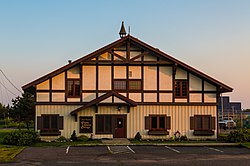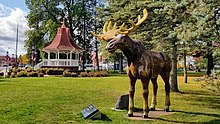world.wikisort.org - USA
Biwabik (/ˈbaɪwəbɪk/)[4] is a city in Saint Louis County, Minnesota, United States. The population was 961 at the 2020 census.[5]
Biwabik | |
|---|---|
City | |
 City of Biwabik Public Works Garage | |
 Location of the city of Biwabik within Saint Louis County, Minnesota | |
| Coordinates: 47°32′0″N 92°20′32″W | |
| Country | United States |
| State | Minnesota |
| County | Saint Louis |
| Area | |
| • Total | 9.93 sq mi (25.72 km2) |
| • Land | 8.76 sq mi (22.69 km2) |
| • Water | 1.17 sq mi (3.03 km2) |
| Elevation | 1,450 ft (440 m) |
| Population (2020) | |
| • Total | 961 |
| • Density | 109.70/sq mi (42.36/km2) |
| Time zone | UTC-6 (Central (CST)) |
| • Summer (DST) | UTC-5 (CDT) |
| ZIP codes | 55708 |
| Area code | 218 |
| FIPS code | 27-06148[3] |
| GNIS feature ID | 0660819[2] |
| Website | www.cityofbiwabik.com |

State Highway 135 (MN 135) and Vermilion Trail (County 4) are two of the main routes in Biwabik.
Its name is derived from the Ojibwe word for Iron: Biwabiko-nabik-wan. Biwabik is the gateway to the East Range on the Mesabi Iron Range.
Biwabik is a Bavarian-themed town that greets visitors to Giants Ridge Resort with two award-winning golf courses and acclaimed ski area, plus trails, lakes, lodging and dining. With the Mesabi Trail connecting the community to Giants Ridge and Vermilion Trail Campground on Embarrass Lake, this scenic city is a destination any time of year. Visit during the Fourth of July for the popular Calithumpian Parade, in September for Honktoberfest, an Oktoberfest which honors Honk the Moose and come back the first Saturday in December for Weihnachtsfest, with fireworks, delightful music and food, and lights.[6]
Recreation
Biwabik is the home of Giants Ridge Golf and Ski Resort. Golf Digest ranked Giants Ridge as an “Editors Choice” in 2019 as one of “The Best Golf Resorts in the Midwest.” Golf Digest has also ranked the Quarry the #1 public course in the state and #4 overall. The Legend has ranked as the #4 public course in the state and #14 overall.[7]
The Giants Ridge Bike Park features 10 lift-served gravity (downhill) mountain bike trails Featuring berms, jumps, rollers and rock gardens, our downhill trail system is designed for riders of all ability levels and embraces the scenic but rugged terrain of Giants Ridge. Giants Ridge welcomes XC riders to explore the 9.2 miles of purpose-built cross country mountain bike trail winding through the Superior National Forest.[8]
Biwabik is also plays host to road cycling, mountain biking, golf, skiing, tubing, snowshoeing, boating, fishing, hunting, ATV and snowmobiling. Biwabik is a recreational town. The Mesabi Trail and the East Range Multi Use Trail is in Biwabik, with several connection opportunities.
Events
The Biwabik Area Civic Association hosts several events each year:[9]
- Music in the Park - Thursday nights in the summer
- City Wide Rummage Sale - Spring & Fall
- Honktoberfest - Third weekend of September
- Weihnachtsfest - First weekend of December
Other events include:
- Pepsi Challenge ski race takes place at Giants Ridge in March.[10]
- The Minnesota High School League[11] State Alpine and Nordic Ski Meets at Giants Ridge in February.
Geography
According to the United States Census Bureau, the city has a total area of 10.15 square miles (26.29 km2); 8.97 square miles (23.23 km2) is land and 1.18 square miles (3.06 km2) is water.[12]
Unique to Biwabik is the Mary Ellen Jasper. Mary Ellen Jasper was first discovered in Minnesota in the early 1900s. Mary Ellen Jasper contains 1.88-billion-year-old stromatolite fossils, It's fossilized algae, so the stromatolite is what makes the Mary Ellen unique.[13]
History
Daniel R. Curtin, Wisconsin State Assemblyman and businessman, at one time owned the town site of Biwabik, Minnesota. For 10 years, Curtin was in the lumber and mining business.
Biwabik is a town full of firsts. Biwabik was the first to incorporate as a village on the Iron Range in September of 1892. It was also the first Iron Range town to be served by two railroads, the "Duluth & Iron Range" and the "Duluth, Missabe and Northern Railway". Biwabik had the first large mine on the Mesabi and it was the first on the Iron Range with a steam shovel to mine.[14]
An F3 tornado destroyed homes in the northern and northwestern parts of Biwabik on October 6, 1900, killing ten people in and near the city and injuring 70; six deaths were in one family.[15]
In 1915, a moose visited the town regularly and in the book, "Honk: The Moose", the residents named him "Honk" after the noise he made. This children's book Honk, the Moose, was written by famed author, Phil Stong and illustrated by Kurt Weise. Stong was a teacher and coach at the Biwabik school in the 1919 - 1920 school year. He featured people from Biwabik as characters. The book is a Newbery Honor and on Cattermole's 100 Best Children's Books of the 20th Century. A statue of Honk resides in the City Park on Main Street.
Peter X. Fugina (1908-1994), educator and Minnesota state legislator was born in Biwabik.[16]
Demographics
| Historical population | |||
|---|---|---|---|
| Census | Pop. | %± | |
| 1900 | 1,299 | — | |
| 1910 | 1,690 | 30.1% | |
| 1920 | 2,024 | 19.8% | |
| 1930 | 1,383 | −31.7% | |
| 1940 | 1,304 | −5.7% | |
| 1950 | 1,245 | −4.5% | |
| 1960 | 1,836 | 47.5% | |
| 1970 | 1,483 | −19.2% | |
| 1980 | 1,428 | −3.7% | |
| 1990 | 1,097 | −23.2% | |
| 2000 | 954 | −13.0% | |
| 2010 | 969 | 1.6% | |
| 2020 | 961 | −0.8% | |
| U.S. Decennial Census[17] | |||
2020 census
At the 2020 census, there were 961 people and 323 households in the city.
The racial makeup of the city was 887 White, 13 Native American, 1 Asian, 0 Pacific Islander, and 55 from two or more races. 19.4% German, 10.2% Irish, 9.4% Norwegian, 7% English, 6.5% Polish, 6.4% French, 5.5% Italian and .5% Scottish, according to the 2020 Census.
There were 323 households, of which 14.4% had children under the age of 18 living with them, 26.9% were married couples living together, 22.3% had a female householder with no husband present, 31% we male household, no spouse present. 21.4% had someone living alone who was 65 years of age or older. The average family size was 2.5.
14.4% of the population were under the age of 18, 85.6% from 18 and over, with 21.4 who were 65 years of age or older. The median age was 45.5 years.
The median household income was $41,719 and the median family income was $74,593. About 15.9% of people were below the poverty line, including 10.5% of those under age 18 and 4.7% of those age 65 or over.
See also
- Honk, the Moose, a children's novel based on a story taking place in Biwabik. Written by Phil Stong, illustrated by Kurt Weise.
References
- "2020 U.S. Gazetteer Files". United States Census Bureau. Retrieved July 24, 2022.
- U.S. Geological Survey Geographic Names Information System: Biwabik, Minnesota
- "U.S. Census website". United States Census Bureau. Retrieved 2008-01-31.
- "5 More Minnesota Towns You're Pronouncing Wrong".
- "2010 Census Redistricting Data (Public Law 94-171) Summary File". American FactFinder. U.S. Census Bureau, 2010 Census. Retrieved 23 April 2011.[dead link]
- irt_admin (2019-11-21). "East Range |". ironrange.org. Retrieved 2022-01-01.
- sandrakingadmin. "Giants Ridge Golf Course Reviews | Jeffrey D. Brauer/GolfScapes, Inc". Retrieved 2022-01-01.
- "Giants Ridge on Trailforks". Trailforks. Retrieved 2022-01-01.
- "Biwabik Area Civic Association |". Retrieved 2022-01-01.
- "Pepsi Challenge Main Page". www.pepsichallengeskirace.com. Retrieved 2022-01-01.
- "Minnesota State High School League | Education and Leadership for a Lifetime". Minnesota State High School League. Retrieved 2022-01-01.
- "US Gazetteer files 2010". United States Census Bureau. Archived from the original on 2012-01-25. Retrieved 2012-11-13.
- "Gems of the Iron Range: Mary Ellen Jasper". khou.com. August 19, 2021. Retrieved 2022-01-01.
- Project, The Federal Writers' (2008-10-14). Wpa Guide to the Minnesota Arrowhead. Minnesota Historical Society. ISBN 978-0-87351-709-6.
- Grazulis, Thomas P. (1993). Significant tornadoes, 1680-1991: A Chronology and Analysis of Events. St. Johnsbury, Vermont: Environmental Films. p. 692. ISBN 1-879362-03-1.
- 'Former state representative Peter X. Fugina, 84, dies,' David Chasen, Minneapolis Statr Tribune (Minnesota), March 31, 1994, pg. 6B
- "Census of Population and Housing". Census.gov. Retrieved June 4, 2015.
External links
- City of Biwabik official website
- Biwabik Area Civic Association official website
- Biwabik history and information
На других языках
[de] Biwabik
Biwabik ist eine Stadt im St. Louis County in Minnesota, Vereinigte Staaten. Die Bevölkerungszahl im Jahr 2000 betrug 954. Der Name der Stadt ist von der Bezeichnung für Eisen in der Sprache der Ojibwe, Biwabiko-nabik-wan, abgeleitet.- [en] Biwabik, Minnesota
[ru] Байвабик (город, Миннесота)
Байвабик (англ. Biwabik) — город в округе Сент-Луис, штат Миннесота, США. Население города на 2010 год — 969 человек.Другой контент может иметь иную лицензию. Перед использованием материалов сайта WikiSort.org внимательно изучите правила лицензирования конкретных элементов наполнения сайта.
WikiSort.org - проект по пересортировке и дополнению контента Википедии
